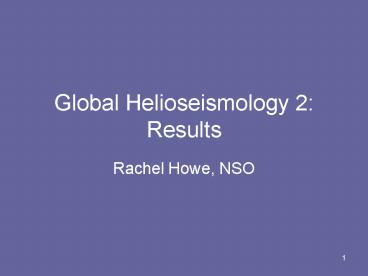Global Helioseismology 2: Results - PowerPoint PPT Presentation
1 / 46
Title: Global Helioseismology 2: Results
1
Global Helioseismology 2 Results
- Rachel Howe, NSO
2
Synopsis
- Mode parameters, mode physics, and the solar
cycle - Frequency changes
- Width, amplitude and asymmetry
- Internal Structure
- Internal Rotation
- The overall picture
- Temporal variations
3
Frequency shifts with solar cycle
4
Frequency shift sensitivity
5
Even splitting coefficients follow magnetic
activity distribution
6
Localized global frequency shifts
7
High-degree frequency shifts
- Mode frequencies are higher in active regions
- (Hindman et al, 2000).
8
High-degree Frequency Sensitivity
- High-frequency modes can have anticorrelation
with activity level.
9
Note on Frequency Shifts
- Sensitivity depends mostly on frequency.
- Shifts are strongly localized to active regions.
- The effect is heavily dominated by the magnetic
features at the surface. - The exact mechanism (sound-speed? temperature?
cavity size? magnetic field?) is still under
debate.
10
Mode Parameters
- Width is inversely proportional to lifetime
- Area under peak mode power (amplitude)
- Power x lifetime Energy Supply Rate
11
Low-degree Mode Width
- l0, 1, 2 modes from GONG and BiSON
12
Low-degree Mode Amplitude
- l0, 1, 2 modes from GONG and BiSON
13
Medium-degree mode parameters
- From Libbrecht, 1988.
14
Mode Energy Varies With Activity
15
High-degree Mode Amplitude
- Amplitude from ring-diagram analysis is
suppressed in active regions.
16
High degree mode amplitude
- But at higher frequencies peak amplitude
increases with frequency.
17
Sensitivity varies with frequency
18
Mode Width Varies With Activity
19
High-degree mode width
- Peaks are broader (shorter lifetimes) in active
regions.
20
High-degree mode width
- But at higher frequencies, linewidth decreases
with activity.
21
Sensitivity varies with frequency
22
Reminder
- Oscillations excited by granulation.
- Might expect active regions to make a difference.
23
Summary
- For trapped modes, power and lifetime decrease
with activity. - High frequency non-trapped modes behave
differently, increasing power and lifetime in
active regions. - The boundary between trapped and untrapped may
change with activity level.
24
Summary of the Summary
- Rule 1 Everything varies with everything else.
- Rule 2 Its more complicated than that.
25
Structure Inversion Results
26
Results of OLA inversion of solar data
Sound speed
Fractional differences between Sun and a model,
in sense (Sun minus model) from BiSON LOWL
data (Basu et al. 1997, MNRAS 291, 243)
Density
27
Constraining solar structure models
- Neutrino discrepancy solved
- All exotic models inconsistent with measured
frequencies - Standard model pretty good, but still discrepancy
below CZ - Near surface poorly understood
28
Depth of convection zone
From an inversion for sound speed, can calculate
W, which in the convection zone takes the
approximately constant value -(G1-1) (except in
regions of partial ionization).
inversion
model
Seismically determined location of base of
convection zone is rcz/R 0.713 /- 0.004
29
Helium abundance
From inversions using u and Y, Richard et
al. (1998) determined helium abundance in the
solar convection zone to be 0.248 /- 0.002
Can also (try to) use the HeII bump in W at
r0.98R either by fitting or from its
signature as a sharp feature
W
30
2-d structure inversion from MDI
- Based on early (1996) MDI data
31
Sound-speed Inversion Results below the surface
32
2-d structure remarks
- Most solar-cycle variation comes from
near-surface activity and goes into the surface
term in inversions. - Is something strange (hot) happening around 60
degrees?
33
Rotation Inversion Results
- The mean rotation profile
- Residuals
- Phase and amplitude from sinusoid fits
34
Rotation Inversion Results
35
Rotation Inversion Results
36
(No Transcript)
37
Penetrating flows
- Vorontsov et al 2002, Science
- MDI, new inversion technique
- High-latitude changes go deep
- Low-latitude flows down to at least 0.92R
38
Zonal Flow Pattern
39
Zonal Flow Pattern
40
Zonal Flow Patterns (Time-Radius)
15
30
0
45
60
MDI OLA
MDI RLS
GONG RLS
41
Sinusoid Fits
- W(r,q)W0(r,q)A(r,q)sinwtf(r,q)
- Phase (left) and amplitude (right) for 11yr
sinusoid fits to zonal flow variation - Fit can be improved by including 2nd harmonic.
MDI OLA
MDI RLS
GONG RLS
42
Zonal Flows the Movie
- Movie based on two-harmonic sinusoid fit to
rotation residuals.
43
Rotation the Movie
- Red is faster rotation, green/blue slower.
- Different colour tables in upper and lower
convection zone.
44
(No Transcript)
45
Flows and Magnetic Activity (Smoothed)
46
Summary of Rotation Results
- Shear layer (tachocline) divides
differentially-rotating convection zone from
solidly-rotating radiative interior. - Near-surface shear has fastest rotation around
0.95R. - Differential pattern persists through convection
zone, not quite radially. - Zonal flow pattern, or torsional oscillation
penetrates much of convection zone. - Pattern has (weak) equatorward and (strong)
poleward branches. - Pattern in the interior is phase-shifted, leading
the surface pattern.
47
Credits
- Thanks to
- W. J. Chaplin (Birmingham)
- J. Christensen-Dalsgaard (Aarhus)
- B. Hindman (CU Boulder)
- J. W. Leibacher (NSO Tucson)
- M. J. Thompson (Sheffield)
48
Further Reading
(Coming June 27)































